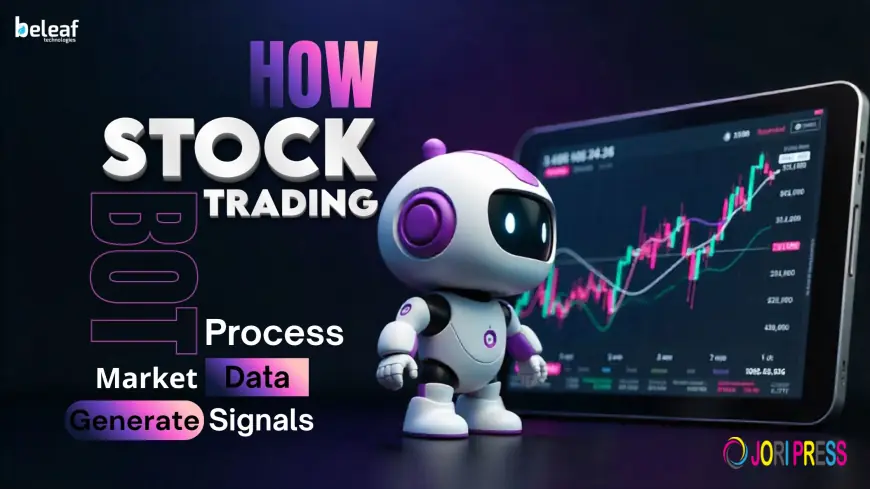How Stock Trading Bots Process Market Data and Generate Signals

In the stock market, timing and information are very important. Traders try to read charts, watch news, and follow indicators, but no one can track every stock or react to every price change. This is why stock trading bots are very useful. These bots scan the market, study data, and create buy or sell signals automatically. They do not feel stress, emotions, or pressure. When we understand how these bots work, we can see why they are so effective and how they make trading faster, calmer, and more accurate.
How Stock Trading Bots Collect and Understand Market Data
Stock trading bots begin by collecting huge amounts of data every second. They connect to stock exchanges, financial websites, news services, and charting platforms. The data they gather includes price changes, trading volume, order book updates, market depth, news headlines, economic reports, historical price charts, and values from technical indicators. While a human trader can only look at a few things at once, bots can look at everything at the same time.
At first, the data comes in a rough form — just numbers, times, and text. The bot then cleans this data and organizes it. This step is called data preprocessing. The bot removes mistakes, fills in missing pieces, and smooths out noise. Clean and organized data helps the bot make better trading decisions. After this step, the bot is ready to study the market more deeply.
How Bots Analyze Patterns and Market Behavior
Once the bot has the data, it starts looking for patterns. This is one of the most important things a trading bot does. It uses many methods to understand what is happening in the market.
One method is technical analysis. The bot calculates indicators such as moving averages, RSI, MACD, and Bollinger Bands. It checks if the stock is trending up, trending down, or moving sideways. It also looks at momentum, volatility, and levels where the price often changes direction.
The bot also uses price action analysis, which means studying candlestick patterns, chart shapes, breakouts, and pullbacks. It compares the current price behavior with past patterns to see if something similar is happening again.
Advanced bots use machine learning. This allows them to learn from millions of past prices and find patterns that humans may not see. Machine learning helps bots predict trends, detect unusual price moves, and adjust their strategy when the market changes.
Some bots also use sentiment and news analysis. They read news or social media posts using natural language processing (NLP). This helps them understand whether the news is positive or negative and lets them react quickly.
Bots also use pattern recognition to spot chart patterns like triangles, double tops, and head-and-shoulders. They can analyze thousands of stocks at the same time, which is impossible for a human.
All these types of analysis help the bot see the market clearly and get ready to create strong trading signals.
How Trading Bots Generate Buy and Sell Signals
After studying the data, the bot must decide what to do — buy, sell, or wait. Bots make decisions using rules, logic, and math, not emotions.
Some bots use simple rules. For example, a bot might buy when the price moves above a moving average or sell when RSI becomes too high. These bots always follow their rules and never change them.
Other bots use multiple conditions at the same time. A bot may only buy if the trend is strong, volume is rising, momentum is positive, and no big news is coming. This helps the bot make safer, more reliable decisions.
The most advanced bots use AI predictions. These bots learn from past data and can sometimes predict price moves before human traders notice them.
Bots also think about risk management. They set safe stop-loss levels, take-profit levels, position sizes, and risk per trade. This protects traders from losing too much money. A good bot always thinks about risk before thinking about profit.
Why Trading Bots Work Better Without Emotions
One big advantage of trading bots is that they do not feel emotions. Humans often feel fear, greed, or stress, which can lead to bad choices. People may hesitate, chase trades, or close trades too early. Bots do not do this. They follow their rules calmly, step by step. They do not panic when the market moves fast or get excited after a winning streak. This discipline helps them produce more stable and consistent results.
Bots Process Data Faster Than Any Human Can
Bots also have a huge speed advantage. They can study thousands of stocks in just a few milliseconds. They react instantly to price changes, volume spikes, or news events. This speed helps traders catch opportunities that humans cannot. It also helps avoid losses in fast-moving conditions. Bots work 24 hours a day without getting tired, so they never miss a moment.
How Bots Keep Improving Over Time
Many modern bots use machine learning, which allows them to learn and get better over time. They review their past trades, learn from mistakes, and update their strategies. The longer the bot runs, the smarter it becomes. Over time, it finds better patterns and avoids weak or risky setups, making trading safer and more effective.
Why Automated Trading Is Becoming the Future
Stock trading bots are becoming more popular because they offer everything traders need: speed, accuracy, consistency, discipline, smart risk control, and continuous learning. Bots help traders save time, reduce stress, and make more informed decisions. As technology grows, bots will become even better and more helpful.
Final Thoughts
Stock trading bot works by collecting large amounts of market data, studying patterns, and creating signals based on logic and statistics. They help traders make smarter choices and understand the market better. Whether someone is new to trading or experienced, trading bots offer a more stable, comfortable, and efficient way to trade. Bots bring speed, discipline, and intelligence — qualities that are becoming essential in today’s stock market.
What's Your Reaction?
 Like
0
Like
0
 Dislike
0
Dislike
0
 Love
0
Love
0
 Funny
0
Funny
0
 Angry
0
Angry
0
 Sad
0
Sad
0
 Wow
0
Wow
0
















































